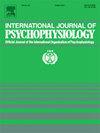Heartfelt gaze: Cardiac afferent signals and vagal tone affect gaze perception
IF 2.5
3区 心理学
Q3 NEUROSCIENCES
引用次数: 0
Abstract
Perceiving others' gaze direction is an essential aspect of social interactions. The cone of direct gaze (CoDG) refers to the range within which an observer perceives a gaze as looking directly at them. Previous research has demonstrated that self-relevant exteroceptive cues can widen the CoDG. However, the effect of self-relevant interoceptive information on the CoDG remains unknown. This study investigated the contribution of cardiac afferent signals and vagal tone to the perception of gaze from others. We used a modified gaze discrimination task to synchronize face stimuli with various gaze directions to specific phases of the cardiac cycle. Results revealed that participants with higher heart rate variability (HRV) exhibited a wider CoDG during cardiac systole (when cardiac signals are maximally represented in the brain). However, no effect was observed during cardiac diastole (when cardiac signals are quiescent). Moreover, this effect was independent of individual differences in anxiety levels and autistic traits. These findings are evidence that individuals with greater cardiac vagal control are more sensitive to cardiac afferent signals during systole, which leads to a stronger self-directed perception of others' gaze under transient and ambiguous gaze perception conditions. Our findings highlight the self-referential role of cardiac interoceptive signals in gaze perception and expand our knowledge of interoceptive influences on social judgment.
求助全文
约1分钟内获得全文
求助全文
来源期刊
CiteScore
5.40
自引率
10.00%
发文量
177
审稿时长
3-8 weeks
期刊介绍:
The International Journal of Psychophysiology is the official journal of the International Organization of Psychophysiology, and provides a respected forum for the publication of high quality original contributions on all aspects of psychophysiology. The journal is interdisciplinary and aims to integrate the neurosciences and behavioral sciences. Empirical, theoretical, and review articles are encouraged in the following areas:
• Cerebral psychophysiology: including functional brain mapping and neuroimaging with Event-Related Potentials (ERPs), Positron Emission Tomography (PET), Functional Magnetic Resonance Imaging (fMRI) and Electroencephalographic studies.
• Autonomic functions: including bilateral electrodermal activity, pupillometry and blood volume changes.
• Cardiovascular Psychophysiology:including studies of blood pressure, cardiac functioning and respiration.
• Somatic psychophysiology: including muscle activity, eye movements and eye blinks.

 求助内容:
求助内容: 应助结果提醒方式:
应助结果提醒方式:


